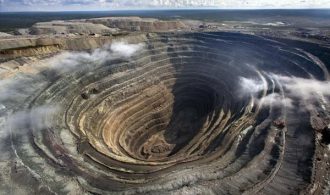Have you ever wondered how the diamond in your ring gets from the earth to your finger? Did you know that mining for diamonds is one of the most resource-heavy and lengthy processes that man must go through in order to find these precious stones? Technology has advanced and made the process slightly easier but finding diamonds remains a combination of science and art. Here are some of the techniques applied to find and mine these most beautiful gems:
Pipe Mining
There is no point mining an area with no knowledge of what lies beneath, you could well be wasting your time, efforts and money. Geologists can trace secondary diamond sources to calculate where the primary stones will be located. This is where prospecting becomes important. If you want to hit pay dirt, you need to know where to look.
When diamond pipes are found and confirmed as solid and profitable – workers will lower shanks into the ground and begin to extract massive amounts of soil. They will often check for animals or life forms before letting anyone go in. If they find there are a lot of creatures living in their its possible to send in a Pest Control Southend company The soil and rocks that are extracted are not normally examined at this point, in order to save time and resources. The dirt is moved to a specialist plant where the ore is examined, processed and rough diamonds extracted. It’s not any easy feat, as hundreds of tons of dirt can often produce just one carat of quality rough diamonds.
The next part of the process is to sort any rough diamonds into different quality categories when they are then sold for cutting, polishing and used in various products. Therefore, the process between ground and finger is a long one, with many stages and involving lots of people.

Alluvial Mining
Over the course of millions of years, the Earth has undergone dramatic changes and water has often driven deposits away from their original Kimberlite pipes. Therefore, there is always a possibility that diamonds can be found far out to sea. The method used for mining these secondary sites in off-shore, beach or river locations is called alluvial mining.
This process involves building dams and diverting water courses to expose the riverbanks and beds that could contain the desired ore. Kimberlite pipes can be found at depths of lower than 15 metres and once this area is reached, the extracted material is sent to processing plants to be examined and sorted.
Artisanal mining is another method that involves a more low-tech approach, with lesser equipment and more manual labour. The process takes longer, but the benefits include a shorter post-extraction processing time, as rough diamonds are identified right there and then on the spot.
Environmental Impact
Diamond mines cause a big impact on their local environment. Huge man-made holes are left behind, such as the Kimberley open mine in South Africa which has produced some of the most famous diamonds in the world. These mine holes can be seen from space.

